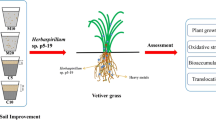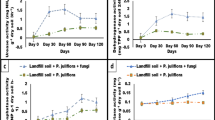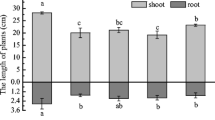Abstract
Although plant-white-rot fungi (WRF) remediation is considered efficient in improving polycyclic aromatic hydrocarbon (PAH)–contaminated soil, the prospects for using it remain poorly known. Therefore, we evaluated whether the WRF Crucibulum laeve could improve the phytoremediation of PAH-contaminated soil by Salix viminalis L. A 60-day pot experiment was conducted to investigate the effects of C. laeve inoculation (using two inoculation treatments and a non-inoculated control) on the phytoremediation potential, growth, and antioxidant metabolism of S. viminalis cultivated in PAH-contaminated soil. The S. viminalis-C. laeve association synergistically caused the highest PAH removal rate. Under the S. viminalis-C. laeve treatment, 80% of the biological concentration and translocation factors for all tissues of S. viminalis were > 1, whereas only 20% of these factors were > 1 when S. viminalis was used alone. C. laeve inoculation remarkably enhanced phytoremediation by promoting S. viminalis–based phytoextraction of PAHs from soils. Furthermore, although C. laeve inoculation altered the antioxidant metabolism of S. viminalis by inducing oxidative stress, thereby inhibiting plant growth, the plant’s hardiness enabled it to survive and grow normally for 60 days after treatment. Therefore, phytoremediation using S. viminalis inoculated with C. laeve can be considered a feasible approach for the phytoremediation of PAH-contaminated soil.







Similar content being viewed by others
References
Ahammed GJ, Wang MM, Zhou YH, Xia XJ, Mao WH, Shi K, Yu JQ (2010) The growth, photosynthesis and antioxidant defense responses of five vegetable crops to phenanthrene stress. Ecotoxicol Environ Saf 80:132–139. https://doi.org/10.1016/j.ecoenv.2012.02.015
Alagić SČ, Maluckov BS, Radojičić VB (2014) How can plants manage polycyclic aromatic hydrocarbons? May these effects represent a useful tool for an effective soil remediation? A review. Clean Techn Environ Policy 17:597–614. https://doi.org/10.1007/s10098-014-0840-6
Bamforth SM, Singleton I (2005) Bioremediation of polycyclic aromatic hydrocarbons: current knowledge and future directions. J Chem Technol Biotechnol 80:723–736. https://doi.org/10.1002/jctb.1276
Beers RF, Sizer IW (1952) A spectrophotometric method for measuring the breakdown of hydrogen peroxide by catalase. J Biol Chem 195:133–140
Berndes G, Fredrikson F, Börjesson P (2004) Cadmium accumulation and Salix-based phytoextraction on arable land in Sweden. Agric Ecosyst Environ 103:207–223. https://doi.org/10.1016/j.agee.2003.09.013
Borràs E, Caminal G, Sarrà M, Novotný Č (2010) Effect of soil bacteria on the ability of polycyclic aromatic hydrocarbons (PAHs) removal by Trametes versicolor and Irpex lacteus from contaminated soil. Soil Biol Biochem 42:2087–2093. https://doi.org/10.1016/j.soilbio.2010.08.003
Bradford MM (1976) A rapid and sensitive method for the quantitation of microgram quantities of protein utilizing the principle of protein-dye binding. Anal Biochem 72:248–254. https://doi.org/10.1016/0003-2697(76)90527-3
Buonanno G, Giovinco G, Morawska L, Stabile L (2015) Lung cancer risk of airborne particles for Italian population. Environ Res 142:443–451. https://doi.org/10.1016/j.envres.2015.07.019
Chance B, Maehly AC (1955) Assay of catalases and peroxidases. Methods Enzymol 2:764–775. https://doi.org/10.1016/S0076-6879(55)02300-8
Covino S, Čvančarová M, Muzikář M, Svobodová K, D’Annibale A, Petruccioli M, Federici F, Křesinová Z, Cajthaml T (2010a) An efficient PAH-degrading Lentinus (Panus) tigrinus strain: effect of inoculum formulation and pollutant bioavailability in solid matrices. J Hazard Mater 183:669–676. https://doi.org/10.1016/j.jhazmat.2010.07.078
Covino S, Svobodová K, Čvančarová M, D’Annibale A, Petruccioli M, Federici F, Křesinová Z, Galli E, Cajthaml T (2010b) Inoculum carrier and contaminant bioavailability affect fungal degradation performances of PAH-contaminated solid matrices from a wood preservation plant. Chemosphere 79:855–864. https://doi.org/10.1016/j.chemosphere.2010.02.038
Covino S, Svobodová K, Křesinová Z, Petruccioli M, Federici F, D’Annibale A, Čvančarová M, Cajthaml T (2010c) In vivo and in vitro polycyclic aromatic hydrocarbons degradation by Lentinus (Panus) tigrinus CBS 577.79. Bioresour Technol 101:3004–3012. https://doi.org/10.1016/j.biortech.2009.12.020
Davis MW, Lamar RT (1992) Evaluation of methods to extract ergosterol for quantitation of soil fungal biomass. Soil Biol Biochem 24:189–198. https://doi.org/10.1016/0038-0717(92)90218-M
de Boer J, Wagelmans M (2016) Polycyclic aromatic hydrocarbons in soil - practical options for remediation. Clean Soil Air Water 44:648–653. https://doi.org/10.1002/clen.201500199
Declercq I, Cappuyns V, Duclos Y (2012) Monitored natural attenuation (MNA) of contaminated soils: State of the art in Europe—A critical evaluation. Sci. Total Environ 426:393–405
Dubrovskaya E, Pozdnyakova N, Golubev S, Muratova A, Grinev V, Bondarenkova A, Turkovskaya O (2017) Peroxidases from root exudates of Medicago sativa and Sorghum bicolor: catalytic properties and involvement in PAH degradation. Chemosphere 169:224–232. https://doi.org/10.1016/j.scitotenv.2014.11.046
Dueholm MS, Marques IG, Karst SM, D’Imperio S, Tale VP, Lewis D, Nielsen PH, Nielsen JL (2015) Survival and activity of individual bioaugmentation strains. Bioresour Technol 186:192–199. https://doi.org/10.1016/j.biortech.2015.02.111
Elstner EF, Heupel A (1976) Inhibition of nitrite formation from hydroxylammoniumchloride: a simple assay for superoxide dismutase. Anal Biochem 70:616–620. https://doi.org/10.1016/0003-2697(76)90488-7
Foyer CH, Halliwell B (1976) The presence of glutathione and glutathione reductase in chloroplasts: a proposed role in ascorbic acid metabolism. Planta 133:21–25. https://doi.org/10.1007/BF00386001
Gao D, Du L, Yang J, Wu WM, Liang H (2010) A critical review of the application of white rot fungus to environmental pollution control. Crit Rev Biotechnol 30:70–77. https://doi.org/10.3109/07388550903427272
Gao M, Dong Y, Zhang Z, Song W, Qi Y (2017) Growth and antioxidant defense responses of wheat seedlings to di-n-butyl phthalate and di (2-ethylhexyl) phthalate stress. Chemosphere 172:418–428. https://doi.org/10.1016/j.chemosphere.2017.01.034
Garcia-Delgado C, Alfaro-Barta I, Eymar E (2015a) Combination of biochar amendment and mycoremediation for polycyclic aromatic hydrocarbons immobilization and biodegradation in creosote-contaminated soil. J Hazard Mater 285:259–266. https://doi.org/10.1016/j.jhazmat.2014.12.002
Garcia-Delgado C, D’Annibale A, Pesciaroli L, Yunta F, Crognale S, Petruccioli M, Eymar E (2015b) Implications of polluted soil biostimulation and bioaugmentation with spent mushroom substrate (Agaricus bisporus) on the microbial community and polycyclic aromatic hydrocarbons biodegradation. Sci Total Environ 508:20–28. https://doi.org/10.1016/j.scitotenv.2014.11.046
Garcia-Delgado C, Yunta F, Eymar E (2015c) Bioremediation of multi-polluted soil by spent mushroom (Agaricus bisporus) substrate: polycyclic aromatic hydrocarbons degradation and Pb availability. J Hazard Mater 300:281–288. https://doi.org/10.1016/j.jhazmat.2015.07.008
García-Sánchez M, Košnář Z, Mercl F, Aranda E, Tlustoš P (2018) A comparative study to evaluate natural attenuation, mycoaugmentation, phytoremediation, and microbial-assisted phytoremediation strategies for the bioremediation of an aged PAH-polluted soil. Ecotoxicol Environ Saf 147:165–174. https://doi.org/10.1016/j.ecoenv.2017.08.012
Ghosal D, Ghosh S, Dutta TK, Ahn Y (2016) Current state of knowledge in microbial degradation of polycyclic aromatic hydrocarbons (PAHs): a review. Front Microbiol 7:1369. https://doi.org/10.3389/fmicb.2016.01369
Giannopolitis CN, Ries SK (1977) Superoxide dismutases: I. Occurrence in higher plants. Plant Physiol 59:309–314. https://doi.org/10.1104/pp.59.2.309
Gill SS, Tuteja N (2010) Reactive oxygen species and antioxidant machinery in abiotic stress tolerance in crop plants. Plant Physiol Biochem 48:909–930. https://doi.org/10.1016/j.plaphy.2010.08.016
Haritash AK, Kaushik CP (2009) Biodegradation aspects of polycyclic aromatic hydrocarbons (PAHs): a review. J Hazard Mater 169:1–15. https://doi.org/10.1016/j.jhazmat.2009.03.137
Hodges DM, DeLong JM, Forney CF, Prange RK (1999) Improving the thiobarbituric acid-reactive-substances assay for estimating lipid peroxidation in plant tissues containing anthocyanin and other interfering compounds. Planta 207:604–611. https://doi.org/10.1007/s004250050524
Huang AC, Jiang T, Liu YX, Bai YC, Reed J, Qu B, Goossens A, Nützmann HW, Bai Y, Osbourn A (2019) A specialized metabolic network selectively modulates Arabidopsis root microbiota. Science 364:eaau6389. https://doi.org/10.1126/science.aau6389
Hultgren J, Pizzul L, Castillo MDP, Granhall U (2009) Degradation of PAH in a creosote-contaminated soil. A comparison between the effects of willows (Salix viminalis), wheat straw and a nonionic surfactant. Int J Phytoremediation 12:54–66. https://doi.org/10.1080/15226510902767122
Khan Z, Roman D, Kintz T, de las Alas M, Yap R, Doty S (2014) Degradation, phytoprotection and phytoremediation of phenanthrene by endophyte Pseudomonas putida, PD1. Environ Sci Technol 48:12221–12228. https://doi.org/10.1021/es503880t
King RF, Royle A, Putwain PD, Dickinson NM (2006) Changing contaminant mobility in a dredged canal sediment during a three-year phytoremediation trial. Environ Pollut 143:318–326. https://doi.org/10.1016/j.envpol.2005.11.024
Kohli SK, Handa N, Bali S, Arora S, Sharma A, Kaur R, Bhardwaj R (2018) Modulation of antioxidative defense expression and osmolyte content by co-application of 24-epibrassinolide and salicylic acid in Pb exposed Indian mustard plants. Ecotoxicol Environ Saf 147:382–393. https://doi.org/10.1016/j.ecoenv.2017.08.051
Košnář Z, Mercl F, Perná I, Tlustoš P (2016) Investigation of polycyclic aromatic hydrocarbon content in fly ash and bottom ash of biomass incineration plants in relation to the operating temperature and unburned carbon content. Sci Total Environ 563-564:53–61. https://doi.org/10.1016/j.scitotenv.2016.04.059
Kuppusamy S, Thavamani P, Venkateswarlu K, Lee YB, Naidu R, Megharaj M (2017) Remediation approaches for polycyclic aromatic hydrocarbons (PAHs) contaminated soils: technological constraints, emerging trends and future directions. Chemosphere 168:944–968. https://doi.org/10.1016/j.chemosphere.2016.10.115
Lladó S, Gràcia E, Solanas AM, Viñas M (2013) Fungal and bacterial microbial community assessment during bioremediation assays in an aged creosote-polluted soil. Soil Biol Biochem 67:114–123. https://doi.org/10.1016/j.soilbio.2013.08.010
Mahmud JA, Hasanuzzaman M, Nahar K, Rahman A, Hossain MS, Fujita M (2017) Maleic acid assisted improvement of metal chelation and antioxidant metabolism confers chromium tolerance in Brassica juncea L. Ecotoxicol Environ Saf 144:216–226. https://doi.org/10.1016/j.ecoenv.2017.06.010
Mahmud JA, Hasanuzzaman M, Nahar K, Borhannuddin Bhuyan MHM, Fujita M (2018) Insights into citric acid-induced cadmium tolerance and phytoremediation in Brassica juncea L.: coordinated functions of metal chelation, antioxidant defense and glyoxalase systems. Ecotoxicol Environ Saf 147:990–1001. https://doi.org/10.1016/j.ecoenv.2017.09.045
Marmiroli M, Pietrini F, Maestri E, Zacchini M, Marmiroli N, Massacci A (2011) Growth, physiological and molecular traits in Salicaceae trees investigated for phytoremediation of heavy metals and organics. Tree Physiol 31:1319–1334. https://doi.org/10.1093/treephys/tpr090
Mirsal IA (2008) Soil pollution origin, monitoring & remediation. Verlag Berlin, Heidelberg, Berlin https://doi.org/10.1007/978-3-540-70777-6
Nakano Y, Asada K (1981) Hydrogen peroxide is scavenged by ascorbate-specific peroxidase in spinach chloroplasts. Plant Cell Physiol 22:867–880. https://doi.org/10.1093/oxfordjournals.pcp.a076232
Niu M, Huang Y, Sun S, Sun J, Cao H, Shabala S, Bie Z (2018) Root respiratory burst oxidase homologue-dependent H2O2 production confers salt tolerance on a grafted cucumber by controlling Na+ exclusion and stomatal closure. J Exp Bot 69:3465–3476
Nxele X, Klein A, Ndimba BK (2017) Drought and salinity stress alters ROS accumulation, water retention, and osmolyte content in sorghum plants. S Af J Bot 108:261–266. https://doi.org/10.1016/j.sajb.2016.11.003
Oleszczuk P, Baran S (2005) Polycyclic aromatic hydrocarbons content in shoots and leaves of willow (Salix viminalis) cultivated on the sewage sludge-amended soil. Water Air Soil Pollut 168:91–111. https://doi.org/10.1007/s11270-005-0884-7
Önneby K (2005) Phytoremediation of a highly creosote-contaminated soil by means of Salix viminalis. Inst. för markvetenskap, Master’s Thesis. Swedish University of Agricultural Sciences, Uppsala, pp 50
Rahman A, Mostofa MG, Nahar K, Hasanuzzaman M, Fujita M (2015) Exogenous calcium alleviates cadmium-induced oxidative stress in rice (Oryza sativa L.) seedlings by regulating the antioxidant defense and glyoxalase systems. Braz J Bot 39:393–407. https://doi.org/10.1007/s40415-015-0240-0
Rajtor M, Piotrowska-Seget Z (2016) Prospects for arbuscular mycorrhizal fungi (AMF) to assist in phytoremediation of soil hydrocarbon contaminants. Chemosphere 162:105–116. https://doi.org/10.1016/j.chemosphere.2016.07.071
Reichenauer TG, Germida JJ (2008) Phytoremediation of organic contaminants in soil and groundwater. ChemSusChem 1:708–717. https://doi.org/10.1002/cssc.200800125
Reina R, Liers C, Ocampo JA, García-Romera I, Aranda E (2013) Solid state fermentation of olive mill residues by wood- and dung-dwelling Agaricomycetes: effects on peroxidase production, biomass development and phenol phytotoxicity. Chemosphere 93:1406–1412. https://doi.org/10.1016/j.chemosphere.2013.07.006
Rubin E, Burhan Y (2006) Noncombustion technologies for remediation of persistent organic pollutants in stockpiles and soil. Remediat J 16:23–42. https://doi.org/10.1002/rem.20099
Shen Y, Li J, Gu R, Yue L, Zhan X, Xing B (2017) Phenanthrene-triggered chlorosis is caused by elevated chlorophyll degradation and leaf moisture. Environ Pollut 220:1311–1321. https://doi.org/10.1016/j.envpol.2016.11.003
Smith KE, Schwab AP, Banks MK (2008) Dissipation of PAHs in saturated, dredged sediments: a field trial. Chemosphere 72:1614–1619. https://doi.org/10.1016/j.chemosphere.2008.03.020
Sumithra K, Jutur PP, Carmel BD, Reddy AR (2006) Salinity-induced changes in two cultivars of Vigna radiata: responses of antioxidative and proline metabolism. Plant Growth Regul 50:11–22. https://doi.org/10.1007/s10725-006-9121-7
Takahashi F, Suzuki T, Osakabe Y, Betsuyaku S, Kondo Y, Dohmae N, Fukuda H, Yamaguchi-Shinozaki K, Shinozaki K (2018) A small peptide modulates stomatal control via abscisic acid in long-distance signalling. Nature 556:235–238. https://doi.org/10.1038/s41586-018-0009-2
Thounaojam TC, Panda P, Mazumdar P, Kumar D, Sharma GD, Sahoo L, Sanjib P (2012) Excess copper induced oxidative stress and response of antioxidants in rice. Plant Physiol Biochem 53:33–39. https://doi.org/10.1016/j.plaphy.2012.01.006
Tian W, Zhao J, Zhou Y, Qiao K, Jin X, Liu Q (2017) Effects of root exudates on gel-beads/reeds combination remediation of high molecular weight polycyclic aromatic hydrocarbons. Ecotoxicol Environ Saf 135:158–164. https://doi.org/10.1016/j.ecoenv.2016.09.021
Tornberg K, Bååth E, Olsson S (2003) Fungal growth and effects of different wood decomposing fungi on the indigenous bacterial community of polluted and unpolluted soils. Biol Fertil Soils 37:190–197. https://doi.org/10.1007/s00374-002-0574-1
Toyama T, Furukawa T, Maeda N, Inoue D, Sei K, Mori K, Kikuchi S, Ike M (2011) Accelerated biodegradation of pyrene and benzo [a] pyrene in the Phragmites australis rhizosphere by bacteria-root exudate interactions. Water Res 45:1629–1638. https://doi.org/10.1016/j.watres.2010.11.044
Ucisik AS, Trapp S (2008) Uptake, removal, accumulation, and phytotoxicity of 4-chlorophenol in willow trees. Arch Environ Contam Toxicol 54:619–627. https://doi.org/10.1007/s00244-007-9065-6
USEPA (1996) Method 8275A. Semivolatile organic compounds (PAHs and PCBs) in soils/ sludges and solid wastes using thermal extraction/gas chromatography/mass spectrometry (TE/GC/MC). Available at https://www.epa.gov/sites/production/files/ 2015-12/documents/8275a.pdf (verified 4 April 2016)
USEPA (2007) Method 3550C. Ultrasonic Extraction. Available at https://www.epa.gov/ sites/production/files/2015-12/documents/3550c.pdf (verified 4 April 2016)
Velikova V, Yordanov I, Edreva A (2000) Oxidative stress and some antioxidant systems in acid rain-treated bean plants: protective role of exogenous polyamines. Plant Sci 151:59–66. https://doi.org/10.1016/S0168-9452(99)00197-1
Zhan X, Zhu M, Shen Y, Yue L, Li J, Gardea-Torresdey JL, Xu G (2018) Apoplastic and symplastic uptake of phenanthrene in wheat roots. Environ Pollut 233:331–339. https://doi.org/10.1016/j.envpol.2017.10.056
Acknowledgments
We thank Shuo Jiao from Northwest A&F University for the advice on our experiments.
Funding
This work was financially supported by the Fundamental Research Funds for the Central Non-profit Research Institution of the Chinese Academy of Forestry (CAF) [Grant No. CAFYBB2018ZB002] and the National Natural Science Foundation of China [Grant No. 31700533].
Author information
Authors and Affiliations
Corresponding author
Ethics declarations
Conflict of interest
The authors declare that they have no conflict of interest.
Additional information
Responsible editor: Elena Maestri
Publisher’s note
Springer Nature remains neutral with regard to jurisdictional claims in published maps and institutional affiliations.
Rights and permissions
About this article
Cite this article
Ma, X., Li, X., Liu, J. et al. Enhancing Salix viminalis L.–mediated phytoremediation of polycyclic aromatic hydrocarbon–contaminated soil by inoculation with Crucibulum laeve (white-rot fungus). Environ Sci Pollut Res 27, 41326–41341 (2020). https://doi.org/10.1007/s11356-020-10125-3
Received:
Accepted:
Published:
Issue Date:
DOI: https://doi.org/10.1007/s11356-020-10125-3




